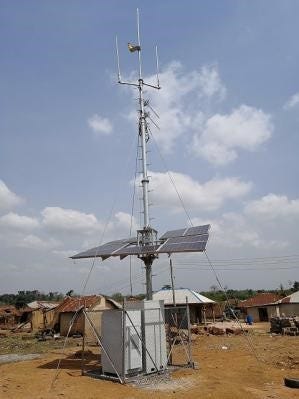Connect the Unconnected: Huawei Aims to Realize Ubiquitous Coverage in Rural Areas and Bridge the Wide Digital Gap Between Urban and Rural Areas
March 6, 2019
While we embrace 5G, 700 million people in rural areas around the world still have no access to the network. Huawei has offered a new solution to this problem.
Huang Haifeng
We can experience 4G anytime anywhere, we use 5G applications, and we treat networks as an indispensable part of our daily lives. However, more than 700 million people in rural areas around the world still cannot make phone calls or access the network (according to GSMA statistics). By the end of 2018, nearly 400,000 villages around the world had no network coverage. The digital gap between cities and the countryside is widening, especially the gap between remote areas and urban areas.
Many people may ask, how does this happen? Don’t operators want to acquire more users? Don’t people in rural areas want to access the network? In areas where the demographic dividend has disappeared, competition between operators is fierce and it is difficult to acquire new users. However, operators would rather attract competitors’ users than develop new users.
In fact, people in the emerging markets that are remote areas have a strong demand for network access, current backward networks in those areas cannot meet the requirements for their life, work, and entertainment. There are many reasons for this, including high costs for network deployment in remote areas, high O&M costs, and a small population. These factors lead to a long payback period of more than a decade.
Are cost-efficient solutions available with low cost, quick site deployment, and short payback periods?
As a forerunner in promoting innovation of mobile base stations, Huawei has been providing new ideas for rural network coverage and cost-efficient scenario-specific site deployment solutions to improve site deployment efficiency. In 2017, Huawei released the RuralStar solution for rural markets to provide network coverage for over 20 million people.
In 2019, Huawei launched the simplified RuralStar_Lite solution for rural areas with small populations. This solution not only allows 100 million people in rural areas to access the network, but also improves people’s livelihood and assists enterprises in fulfilling their social responsibilities.
Challenge: promoting equality between cities and the countryside is difficult but meaningful
The mobile network coverage mode that we are familiar with is to deploy a large number of traditional tower-mounted macro base stations. However, in vast rural areas, it is difficult for operators to implement wide coverage using traditional tower-mounted macro base stations. Even if wide coverage is possible, there are still many areas with weak or no coverage.
Moreover, there is no network coverage in rural areas of many African countries. GSMA data shows that 65% residents in 54 African countries have no access to the network.
With economic development, residents in these areas have an increasingly strong appeal for communication and broadband network access. Given this, the United Nations, governments, and the public all want to promote ubiquitous network coverage in rural areas. For example, in June 2018, the Ministry of Industry and Information Technology of China announced the launch of a new round of universal telecom service, supporting 4G network coverage in 12,000 administrative villages.
This planning is good, but reality is harsh. Numerous challenges have been encountered during network deployment in rural areas. The first challenge is high cost. Deploying traditional tower-mounted macro base stations in remote areas is expensive due to poor infrastructure and a lack of mains power and transmission resources. If a base station has no available supply of mains power, diesel may be used to supply power. This greatly increases the cost of site Maintenance cost .
Another challenge is low ARPU. Rural areas are sparsely populated. For operators, the ARPU is only US$ 1–3 after network deployment. If operators use the traditional network deployment mode in remote areas, the payback period will be longer than 10 years and they may fail to recover costs. Therefore, operators are unwilling to invest in remote areas.
Innovative solution: RuralStar_Lite allows 100 million people in rural areas to access the network
In 2017, Huawei customized the RuralStar solution for rural areas.
This solution can provide low-cost, super-distance voice and digital access for rural areas. It provided 20 million people with their first means for network access shortly after launch. By 2018, Huawei’s RuralStar solution had provided network coverage for 40 million people in rural areas. This solution has been continuously optimized.

How is the magical RuralStar solution implemented? The RuralStar solution is a simplified base station featuring innovations in transmission, infrastructure, main equipment, and energy. The non-line-of-sight (NLOS) transmission technology is used to protect signal transmission from being obstructed by obstacles such as buildings, mountains, and trees. Therefore, operators can mount base stations on simple poles and do not need to deploy high towers. With the 4G self-backhauling technology, RuralStar allows operators to meet the mobile broadband and coverage extension requirements in rural areas without expensive satellites or microwaves. RuralStar also supports remote O&M and access to GSM, UMTS, and LTE networks. RuralStar is environmentally friendly because base stations are powered by solar energy.
The simplified RuralStar solution is far from simple in terms of its capabilities. It provides users with over 10 Mbit/s rates at the cell edge and extended coverage with a maximum distance of 60 km from the nearest tower-mounted base station (wireless signals are sent from the signal source base station and use a three-hop relay). This provides voice and data (over 1 Mbit/s at the cell edge) services.
After two years of development, Huawei found that the RuralStar solution can be further simplified and more and more scenarios would require a simplified RuralStar solution. For this purpose, in 2019 Huawei has released the simplified RuralStar_Lite solution to provide low-cost network access for isolated areas, such as remote villages, islands, and deserts.
RuralStar_Lite is an innovative LTE relay solution. It is widely used in mobile emergency communication, satellite replacement, and repeater replacement, reducing network deployment costs and lease expenses of transmission resources.
The latest RuralStar_Lite solution uses RuralStar as a base to remove requirements for cabinets, ground foundation, and fencing. That is, all equipment is mounted on poles, no cabinets are required for all outdoor equipment, and the steel-frame foundation is directly filled with soil.
In this way, the RuralStar_Lite solution enables operators to quickly deploy networks and provide network coverage for villages with 500 to 1,000 residents in ultra-rural areas, and helps operators quickly acquire users, reduce the payback period to less than three years, and achieve a positive business cycle.
Beyond Connection: Significantly improving the living standards of people in rural areas
From the perspective of users, RuralStar enables villagers to establish connections with the outside world. From the perspective of business, RuralStar helps operators achieve business success.
From the perspective of society, RuralStar promotes network equality between urban and rural areas and improves the living standards of people in rural areas. Various applications generated due to network connectivity bring great changes to people’s lives, including smart agriculture, e-government, telemedicine, mobile healthcare, smart energy, and mobile payments.
Take the Xiaoqushan island in Zhoushan, Zhejiang Province, China as an example. Hundreds of quarriers and their families live on this island, Huawei spent only two days deploying 4G networks. In addition to providing 4G networks for island residents, Huawei also provided 4G fast access networks for quarriers so that they can watch short videos on mobile apps, play online games, and talk with family members in their spare time to relieve fatigue.
The Daliang Mountains in Sichuan Province China are typical remote mountain areas. The Huawei RuralStar solution was used to provide 4G networks for local residents of the Yi ethnic group. Villagers can now enjoy smooth video chat with their relatives that are working in places away from home. Featured local goods can be quickly put on the market through the e-commerce platform. Visitors take photos and videos of the characteristic features for tourism in the villages and share them on the Internet. All of this enhances the connection between people in rural areas and everyone else.

Deep in Gobi of the Aksu area in Xinjiang Province, China, the oil exploration camp was more than 30 kilometers away from the nearest base station. The base station signals could not reach the camp due to mountain interference. China Unicom Xingjiang (Aksu) adopted Huawei’s RuralStar solution to provide 3G/4G coverage for the oil exploration camp and its surrounding areas.
In Nigeria, Huawei has provided 4G networks for children and teachers in mountain villages, facilitating teaching and learning. In Kenya, Huawei RuralStar has been used to provide 4G networks and innovative services such as Mobile Money (mobile wallet) and e-commerce for local villagers, greatly facilitating their daily lives in terms of education, medical care, and so on.

Up to now, Huawei RuralStar has been successfully put into commercial use in more than 50 countries, including Ghana, Nigeria, Kenya, Algeria, Thailand, Mexico, and Peru. Over 110 networks have been deployed worldwide to meet the low-cost, quick site deployment requirements in scenarios such as urban villages, the countryside, deserts, islands, highways, coastlines, plains, hills, and tunnels.
In fact, operators are unwilling to deploy rural networks, and many equipment vendors are reluctant to spend effort in innovating rural networks. Despite all this, Huawei has always been proactively cooperating with governments and operators to practice in rural networks, and has made some remarkable achievements. This reflects the sense of social responsibility on enterprises such as Huawei and operators, and brings tangible benefits to people in rural areas.
Facing a large number of rural areas with no network coverage, Huawei will continuously deploy mobile networks and make digital coverage available to the public under the guidance of the company vision: bringing digital to every person, home, and organization for a fully connected, intelligent world.
About the Author
You May Also Like











.png?width=300&auto=webp&quality=80&disable=upscale)


_1.jpg?width=300&auto=webp&quality=80&disable=upscale)